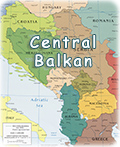Slovenia is a country in central Europe that was part of
Yugoslavia.
Under the Roman Empire, Slovenia was part of the provinces of Pannonia and Noricum. During the 6th century, the region was invaded by the Mongolian Avars and later by Slavs who threw off Avar domination. A period of Bavarian rule ensued, during which most of the people converted to Roman Catholicism. In AD 623, chieftain Franko Samo created the first independent Slovene state, which stretched from Lake Balaton to the Mediterranean. It lasted until late in the 8th century, when the region became part of the Frankish Empire. In the 10th century it was reorganized as the duchy of Carantania by Holy Roman Emperor Otto I. From 1335 until 1918, except for a brief interlude from 1809 to 1814, Slovenes were governed by the Habsburgs of the Austro-Hungarian Empire in the Austrian crown lands of Kärnten (Carinthia), Carniola, and Steiermark (Styria), except for a minority in the republic of Venice.
During the Napoleonic Wars, the region was taken from Austria by France and reorganized as part of the Illyrian Provinces from 1809 to 1814. This brief period of liberal rule fostered Slovene and South Slav nationalism that triumphed at the close of WWI in 1918, with the formation of the Kingdom of the Serbs, Croats, and Slovenes. In 1941, during WWII, Germany, Hungary and Italy divided the territory among themselves. In spite of forced transfers of populations during the war, since 1945 most Slovenes have lived in the Slovenian republic, which in 1947 also acquired Slovenian-speaking districts on the Adriatic Sea (in Istria) from Italy.
As Communist power crumbled throughout Eastern Europe, Slovenia held the first multiparty elections in Yugoslavia since WWII in April 1990. The winning coalition called for independence, and nearly 90 % of Slovenia’s population voted for independence in a referendum in December 1990.
In June 1991, following various political upsets, including Serbian refusal to transfer the country’s rotating presidency to the Croatian representative, Slovenia and Croatia each declared independence from Yugoslavia. The Serb-dominated Yugoslav People’s Army (JNA) sent forces to both republics in an attempt to secure Yugoslavia’s borders. In Slovenia a ten-day war ensued, in which Slovene forces defeated the JNA. The JNA’s defeat, perhaps coupled with fighting in Serbia’s closer neighbor, Croatia, allowed Slovenia quickly to secure true independence as well as international recognition as a separate republic. In January 1992 the European Community, led by Germany, acknowledged the independence of Slovenia, Croatia, and Bosnia and Herzegovina. The United States acknowledged the countries’ independence in April.
Independent Slovenia’s first presidential and parliamentary elections were held in December 1992. Milan Kučan, president of the republic since 1990, was reelected to the office by 64 % of the vote. The center-left Liberal Democracy of Slovenia, headed by Janez Drnovšek, won a plurality of seats in parliament, and Drnovšek became the country’s prime minister. The Christian Democratic Party won the second largest number of parliamentary seats.



